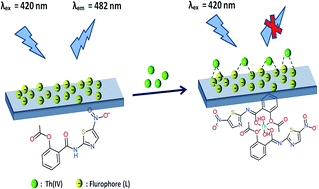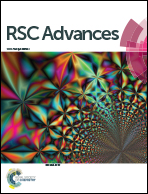A new fluorescent sensor for determination of thorium by thin film of 2-(acetyloxy)-N-(5-nitro-2-thiazolyl)-benzamide embedded in sol–gel matrix
Abstract
A new “turn-off” fluorescent sensor for determination of thorium (Th(IV)) by thin film of 2-(acetyloxy)-N-(5-nitro-2-thiazolyl)-benzamide (L) embedded in sol–gel matrix was introduced. The high efficiency of quenching was caused by non-covalent binding of the positively charged Th(IV) to the negatively charged L. The quenching mechanism is discussed. Judging from temperature and UV-visible absorbance spectra, the quenching mechanism was proved to be static. The stoichiometry and binding ability of L during complexation with Th(IV) were estimated by Job's, Hill's and modified Benesi–Hildebrand plots. Under optimized conditions, a fluorescence quenched at λex/λem = 420/482 (nm) after 2 min, which was linearly related to the concentration of Th(IV) in the range of 3.0 × 10−8 to 1.0 × 10−6 mol L−1. By comparing with selected developed optical sensors, the present sensor exhibits remarkable advantages with satisfactory results that could be used as a tool in nuclear-safeguards material accountability measurements for Th(IV) determination as a “turn-off” fluorescent sensor.


 Please wait while we load your content...
Please wait while we load your content...